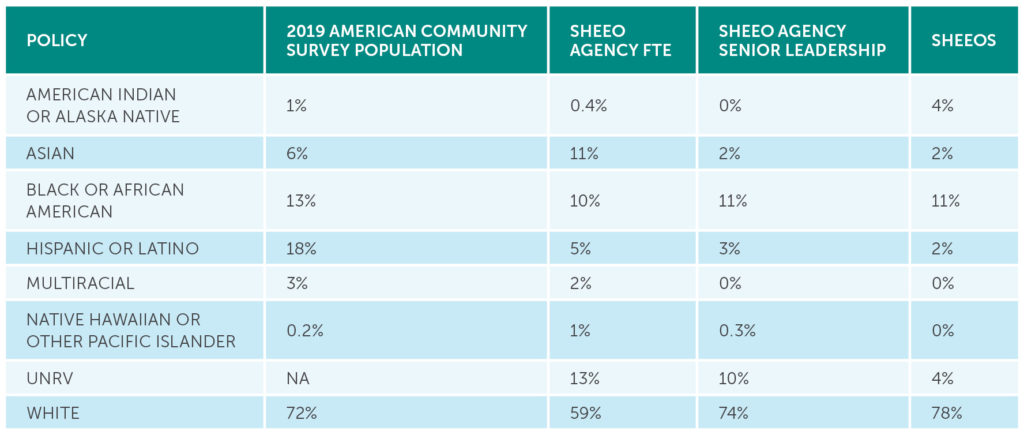Boulder, CO – SHEEO represents the executive officers of statewide governing and coordinating/policy boards who are responsible for overseeing higher education in their state. SHEEO has 61 members representing all 50 states, the District of Columbia, Puerto Rico, and the Northern Mariana Islands. The annual Membership Report uses data collected from its members in the spring of each year to provide an in-depth look at SHEEOs, SHEEO agency senior leaders, and SHEEO agency staff demographic data, along with data on agency size, operating budgets, and key functions. The SHEEO Membership Report was expanded for FY 2020 to include SHEEO agency leadership makeup, race/ethnicity and sex demographics of agency leadership and SHEEOs, and SHEEO prior employment and education experience. The data for this report serve as a benchmark for where the members were before the impacts of the COVID-19 pandemic on membership could be measured.
Brandon Bishop, policy analyst at SHEEO and the primary author of the report, said, “These data provide brand-new insights into state higher education agencies’ staffing, functions, and resources. These data will help our members draw comparisons to like agencies and develop new policies, procedures, and practices moving forward.”
Twenty-nine percent of SHEEO FTE staff are people of color, with the percentage of people of color decreasing in SHEEO agency senior leadership positions (16%) and the SHEEO position (18%) as seen in Table 1. Senior leadership and the SHEEO position are disproportionately white, with 74% of SHEEO senior leadership and 78% of SHEEOs being white. American Indian or Alaska Native, Asian, Black or African American, Hispanic or Latino, multiracial, and Native Hawaiian or Pacific Islander people are underrepresented among SHEEO senior leadership and the SHEEO position. Although Native Hawaiian and Pacific Islander people are not technically underrepresented in senior leadership positions, only 1 out of 312 senior leaders is Native Hawaiian or other Pacific Islander.
Table 1:

The Membership Report and the accompanying Agency Profiles provide data that illustrate how these populations are represented within state agencies and how those numbers compare to their state populations.
A majority of SHEEO FTE staff identify as female (54%), but 44% of SHEEO agency senior leadership and 26% of SHEEOs identify as female. Positions with the highest male representation are information officer (67%) and financial officer (67%), while the positions with the most female representation are communications officer (60%) and academic officer (56%).
Coordinating/policy boards tend to be state agencies or departments within state government that are more likely to perform regulatory functions and resource allocation functions, while governing boards tend to be state systems of higher education and have more formal authority over the institutions in the state. Due to the vast differences in FTE and budgets, these data are best viewed disaggregated by coordinating/policy boards and governing boards. Coordinating/policy boards saw a 1.1 FTE increase from 2019 to 58.9 FTE staff and a $4.8 million increase in their median operating budget from 2019 and now have a median $12.3 million operating budget. Governing boards saw a 2.5 FTE decrease from 2019 and now have 62.5 FTE staff and saw a decrease of $2.6 million from 2019, resulting in a $10.1 million median operating budget. The mean coordinating board operating budget ($15,592,331) was significantly smaller than the mean governing board operating budget ($41,801,501).
The top functions performed by SHEEO agencies in FY 2020 are similar to FY 2019, however, there were increases in both managing equity and diversity programs and information technology coordination.
The top functions performed in FY 2020 included maintaining, collecting, and reporting data on higher education, budgeting and fiscal policy analysis for higher education, research and policy evaluation, and coordination with departments of labor, workforce, and/or economic development.
Seventy-nine percent of SHEEOs have postsecondary education experience; 45% of SHEEOs came directly from working in postsecondary education. However, there are differences in immediate prior job experience between coordinating/policy board SHEEOs and governing board SHEEOs. Coordinating/policy board SHEEOs were more likely to come directly from working in education policy/politics, while governing board SHEEOs were more likely to come from postsecondary education. Fifty-six percent of SHEEOs have a Ph.D. or Ed.D., with 12 (20%) SHEEOs having a degree in public policy and 10 (16%) SHEEOs having a degree in education.
SHEEO President Robert Anderson said, “It is our hope that this report and accompanying web tools will provide SHEEO agencies, other state policymakers, and researchers with critical information they can use to evaluate agencies’ capacity to fulfill their critical missions and the alignment of their functional authorities with the priorities they are charged with carrying out.”
This year, SHEEO has created a Membership Report page on our website. The new page hosts a downloadable dataset of the FY 2020 Membership Report data and interactive State Profiles that show the FY 2020 Membership Report data for each of our members.
###
About the State Higher Education Executive Officers Association (SHEEO)
The State Higher Education Executive Officers Association serves the chief executives of statewide governing, policy, and coordinating boards of postsecondary education and their staffs. Founded in 1954, SHEEO promotes an environment that values higher education and its role in ensuring the equitable education of all Americans, regardless of race/ethnicity, gender, or socioeconomic factors. Together with its members, SHEEO aims to achieve this vision by equipping state higher education executive officers and their staffs with the tools to effectively advance the value of higher education, promoting public policies and academic practices that enable all Americans to achieve success in the 21st century, and serving as an advocate for state higher education leadership.
